| Srl | Item |
| 1 |
ID:
076037
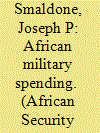

|
|
|
| 2 |
ID:
104713
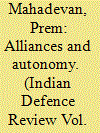

|
|
|
| 3 |
ID:
090605


|
|
|
|
|
| Publication |
2009.
|
| Summary/Abstract |
American primacy continues to characterise the international system, despite trends toward a diffusion of power. The discussion is too often biased in favour of multipolarity due to imprecise or misleading definitions of US primacy. On the basis of a simple definition of what a "pole" is, combining GDP and defence expenditure, only the US can be considered a global pole. The current economic crisis is not changing this reality. Even considering perceptions, soft power, and the ability to translate power into influence, rising powers like China or an aggregate power like the EU have a long way to go before they can get on an equal footing with the United States.
|
|
|
|
|
|
|
|
|
|
|
|
|
|
|
|
| 4 |
ID:
065158
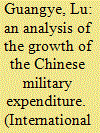

|
|
|
| 5 |
ID:
055068
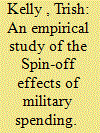

|
|
|
| 6 |
ID:
072644
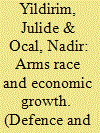

|
|
|
|
|
| Publication |
2006.
|
| Summary/Abstract |
The hostility between India and Pakistan is believed to have led to an arms race between the two countries, which might have contributed to their retarded economic growth. This paper investigates this twin problem of arms race and economic growth for the time period 1949-2003. The empirical results suggest that there is a mutual causal relationship between the military expenditures of India and Pakistan. Even though military expenditure does not Granger cause economic growth in Pakistan, there is causality from military expenditure to economic growth in India. A VAR analysis revealed that military expenditure hinders economic growth in India in the long-run, but it has a growth promoting effect in the short-run.
|
|
|
|
|
|
|
|
|
|
|
|
|
|
|
|
| 7 |
ID:
078233


|
|
|
|
|
| Publication |
2007.
|
| Summary/Abstract |
There is a large literature on the relationship between economic growth and defense spending, but its findings are often contradictory and inconclusive. These results may be partly due to non-linear growth effects of military expenditure and incorrect model specifications. The literature also appears lacking an empirical analysis of interaction between military spending and the arms trade and the impact of these two on growth. This paper investigates this non-linear interaction in the context of the Solow and Barro growth models recommended by Dunne et al.1 (2005). Using fixed effects, random effects, and Arellano-Bond GMM estimators, I examine the growth effects of military expenditure, arms trade, and their interaction in a balanced panel of 28 countries during 1965-2000. The augmented Solow growth model specified in Dunne et al. (2005) yields more robust estimates than the reformulated Barro model. I find that higher military spending and net arms exports separately lead to lower economic growth, but higher military spending is less detrimental to growth when a country is a net arms exporter.
|
|
|
|
|
|
|
|
|
|
|
|
|
|
|
|
| 8 |
ID:
168860
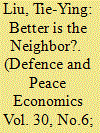

|
|
|
|
|
| Summary/Abstract |
This study applies the Sequential Panel Selection Method (SPSM), to investigate the convergence properties of the military expenditure of the North Atlantic Treaty Organization (NATO) during the period of 1990–2015. Compared to the traditional methods, SPSM considers fundamentally general spatial homogeneous and heterogeneous relationships with countries and examines the evolution of military expenditure. We find that four-fifths of NATO member countries have been convergent with the UK, but no country’s military expenditure is convergent with the US. This means that there is no significant linkage effect in the US for NATO military expenditure. While they are allies of the US, the majority of NATO member countries’ military expenditures are consistent with UK military expenditure. The main reasons are due to the geographical space layout and the international relationship convergence. The results indicate that more than four-fifths of NATO member countries have been coordinated with convergence theory and spillover effect.
|
|
|
|
|
|
|
|
|
|
|
|
|
|
|
|
| 9 |
ID:
066864
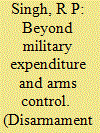

|
|
|
| 10 |
ID:
052931
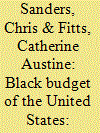

|
|
|
|
|
| Publication |
Apr-Jun 2004.
|
| Summary/Abstract |
An analysis of the federal financial records reveals shocking evidence that a very large poportion of the nation's wealth is eing illegally diverted since several decades ino secret, unaccountable channels and programmes with unspecified purposes, including covert operations and subversions abroad and clandestine military R&D at home.Public institutions have been infiltrated and taken over by shadowy groups in the service of powerful private and vested interests, often at the expense of the common good.
|
|
|
|
|
|
|
|
|
|
|
|
|
|
|
|
| 11 |
ID:
165767
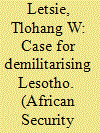

|
|
|
|
|
| Summary/Abstract |
The Kingdom of Lesotho spends around five per cent of its annual budget – some 700 million Maloti ($US52.6 million) in 2017 – on the Lesotho Defence Force (LDF). Lesotho’s geographical position means that the LDF has no meaningful role regarding its primary function of defending the country from external aggression and it hardly engages in its secondary functions. In addition, the LDF has a long history of interference with democratic processes and engaging in human rights abuse. The financial resources currently allocated to the LDF could do far more for security, widely defined, if they were allocated to a number of other government expenditure categories.
|
|
|
|
|
|
|
|
|
|
|
|
|
|
|
|
| 12 |
ID:
100140
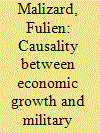

|
|
|
| 13 |
ID:
103028
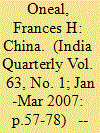

|
|
|
| 14 |
ID:
094813
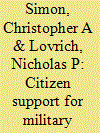

|
|
|
|
|
| Publication |
2010.
|
| Summary/Abstract |
Previous research on public opinion regarding military expenditures in the United States was conducted predominantly in the cold war context. This analysis of public opinion in thirty major U.S. cities over the period 1999 through 2002 revisits this earlier literature in light of changing sociopolitical conditions during a period bracketing the onset of the war on terrorism. The study offers support for much of the earlier research with respect to sources of support for robust military expenditures, in the process illustrating the value of archival data in replicating key research findings in extant literature conducted in a cold war context. The results of the multivariate analysis offer important insights into the sources of public support for military expenditure in the post-9/11 setting.
|
|
|
|
|
|
|
|
|
|
|
|
|
|
|
|
| 15 |
ID:
161544
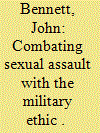

|
|
|
|
|
| Summary/Abstract |
This article explores sexual assault within the military by focusing on the role of norms and institutional culture. This article asserts that poor impulse control is, in part, at the root of sexual assault offenses. The “military ethic,” however, provides a promising institutional means to stigmatize sexual assault and further acculturate service members into law-abiding norms. The military ethic exalts obedience and self-sacrifice. The military ethic is theorized as a norm that may challenge or alter the attitudes and characteristics underlying sexual assault. Additionally, the question of whether the military fosters an institutional “culture of rape” is analyzed. Research into offenders’ motives is discussed, with a focus on the significance of self-control in offending conduct. Research on the features of successful preventive programs is considered. The article concludes by proposing a norms-based preventive policy targeting offender attitudes and capitalizing on successful preventive programs.
|
|
|
|
|
|
|
|
|
|
|
|
|
|
|
|
| 16 |
ID:
084545
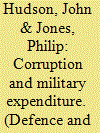

|
|
|
|
|
| Publication |
2008.
|
| Summary/Abstract |
We analyse the determinants of the number of military personnel, military expenditure and arms imports using a panel data of all available countries with data from 1984-2006. The number of military personnel increases with the extent of external threat and with conscription. There is evidence for both economies of scale and the existence of 'ghost soldiers'. Expenditure, given the number of military personnel, increases with the extent of internal threat and the area of the country. Arms imports increase with the extent of external threat, GDP per capita and corruption. Finally, both arms imports and military expenditure impact upon corruption.
|
|
|
|
|
|
|
|
|
|
|
|
|
|
|
|
| 17 |
ID:
123659
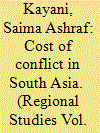

|
|
|
| 18 |
ID:
185495
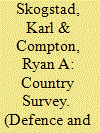

|
|
|
|
|
| Summary/Abstract |
This paper provides an overview of the Canadian defence sector following the Cold War. A review of Canadian defence policy in this period indicates that, though the mission of the Canadian military did not change, fiscal realities forced severe restrictions on the size and capabilities of the organization. Comparisons between Canada and other G7 NATO nations indicate that throughout this period, Canada has consistently devoted fewer resources to the military than its allies. A review of Canada’s defence industrial base and defence policy indicates that this limited funding has led to a small and uncompetitive defence sector in the Canadian economy. Lastly, a regression analysis of Canada’s defence spending is undertaken which reveals that domestic economic variables are the primary determinant of Canadian defence spending during this period.
|
|
|
|
|
|
|
|
|
|
|
|
|
|
|
|
| 19 |
ID:
050281
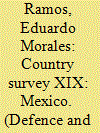

|
|
|
| 20 |
ID:
155839
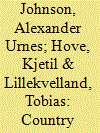

|
|
|
|
|
| Summary/Abstract |
This article examines military expenditure and defence policy in Norway from 1970 to 2013. Until 1990 Norwegian military expenditure remained between 2.5 and 3.0 per cent of Gross Domestic Product (GDP). Despite constant GDP shares, the military expenditure could not sustain a large and properly armed mobilization army. The constant nominal defence budgets of the 1990s accentuated the Norwegian Armed Forces' underlying imbalance between tasks, structure and budget. Around year 2000, large organizational reforms were effectuated, in which costs, the number of man-years, and underlying imbalances between tasks, structure and budget were reduced. Military expenditure increased in nominal terms between 2003 and 2013, while real military expenditure remained practically constant.
|
|
|
|
|
|
|
|
|
|
|
|
|
|
|
|